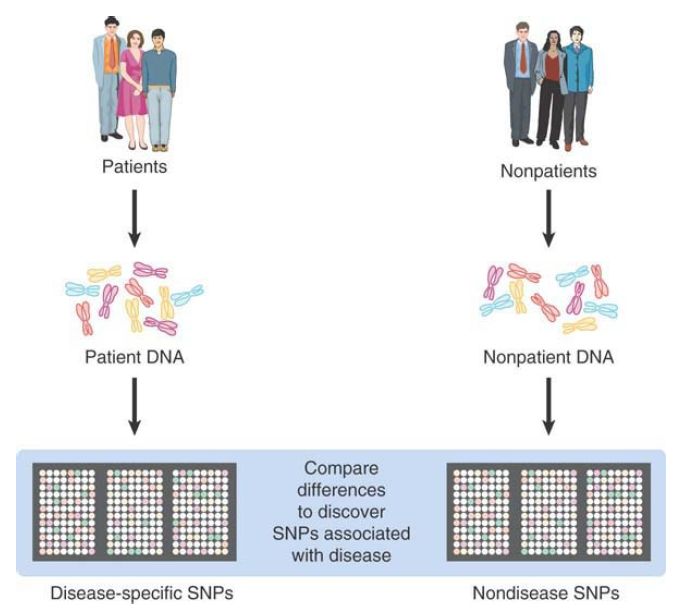


 النبات
النبات
 الحيوان
الحيوان
 الأحياء المجهرية
الأحياء المجهرية
 علم الأمراض
علم الأمراض
 التقانة الإحيائية
التقانة الإحيائية
 التقنية الحيوية المكروبية
التقنية الحيوية المكروبية
 التقنية الحياتية النانوية
التقنية الحياتية النانوية
 علم الأجنة
علم الأجنة
 الأحياء الجزيئي
الأحياء الجزيئي
 علم وظائف الأعضاء
علم وظائف الأعضاء
 الغدد
الغدد
 المضادات الحيوية
المضادات الحيوية|
Read More
Date: 27-12-2015
Date: 21-11-2020
Date: 1-5-2016
|
SNPs Can Be Associated with Genetic Disorders
KEY CONCEPT
- Through genome-wide association studies, researchers can identify SNPs that are more frequently found in patients with a particular disorder.
Genetic markers are not limited to those genetic changes that affect the phenotype; as a result, they provide the basis for an extremely powerful technique for identifying genetic variants at the molecular level. A typical problem concerns a mutation with known effects on the phenotype, where the relevant genetic locus can be placed on a genetic map but for which we have no knowledge about the corresponding gene or its product. Many damaging or fatal human diseases fall into this category. For example, cystic fibrosis shows recessive Mendelian inheritance, but the molecular nature of the mutant function was unknown until it could be identified as a result of characterizing the gene.
If SNPs occur at random in the genome, there should be some near or within any particular target gene. Researchers can identify such markers by virtue of their close linkage to the gene
responsible for the mutant phenotype. If we compare the DNA from patients suffering from a disorder with the DNA of healthy people, we might find that particular markers are always present (or always absent) from the patients.
A hypothetical example is shown in FIGURE 1. This shows the basic approach of a genome-wide association study (GWAS) in which entire genomes of both patients and nonpatients are scanned for SNPs (see the chapter titled Methods in Molecular Biology and Genetic Engineering) and those SNPs that are associated with the disorder are identified. The disorder does not need to be determined by a single gene; it can be a polygenic or multifactorial (with nongenetic influences) disorder, as well. Although some associated SNPs might have no functional relevance to the disorder, others might.

FIGURE .1 In a genome-wide association study, both patients and nonpatient controls for a particular disorder (such as heart disease, schizophrenia, or a single-gene disorder) are screened for SNPs across their genomes. Those SNPs that are statistically more frequently found in patients than in nonpatients can be identified.
The identification of such markers has two important consequences:
- It might offer a diagnostic procedure for detecting the disorder or susceptibility to it. Some of the human diseases that have a known inheritance pattern but are not well defined in molecular
terms cannot be easily diagnosed. If an SNP is associated with the phenotype, healthcare providers can use its presence to diagnose the probability of developing the disorder.
- It might lead to isolation of specific genes influencing the disorder.
The large proportion of polymorphic sites means that every individual has a unique set of SNPs. The particular combination of sites found in a specific region is called a haplotype and
represents a small portion of the complete genotype. The term haplotype was originally introduced to describe the genetic content of the human major histocompatibility locus, a region specifying proteins of importance in the immune system . The term has now been extended to describe the particular combination of alleles or any other genetic markers present in some defined area of the genome. Using SNPs, a detailed haplotype map of the human genome has been made; this enables researchers to map disease-causing genes more easily.
The existence of certain highly polymorphic sites in the genome provides the basis for a technique to establish unequivocal parent– offspring relationships, or to associate a DNA sample with a specific individual. For cases in which parentage is in doubt, a comparison of the haplotype in a suitable genomic region between potential parents and child allows verification of the relationship.
The use of DNA analysis to identify individuals has been called DNA profiling or DNA forensics. Analysis of highly variable “minisatellite” sequences is often used in this technique .



|
|
|
|
دراسة: إجراء واحد لتقليل المخاطر الجينية للوفاة المبكرة
|
|
|
|
|
|
|
"الملح والماء" يمهدان الطريق لأجهزة كمبيوتر تحاكي الدماغ البشري
|
|
|
|
|
|
بالصور: عند زيارته لمعهد نور الإمام الحسين (عليه السلام) للمكفوفين وضعاف البصر في كربلاء.. ممثل المرجعية العليا يقف على الخدمات المقدمة للطلبة والطالبات
|
|
|
|
ممثل المرجعية العليا يؤكد استعداد العتبة الحسينية لتبني إكمال الدراسة الجامعية لشريحة المكفوفين في العراق
|
|
|
|
ممثل المرجعية العليا يؤكد على ضرورة مواكبة التطورات العالمية واستقطاب الكفاءات العراقية لتقديم أفضل الخدمات للمواطنين
|
|
|
|
العتبة الحسينية تستملك قطعة أرض في العاصمة بغداد لإنشاء مستشفى لعلاج الأورام السرطانية ومركز تخصصي للتوحد
|